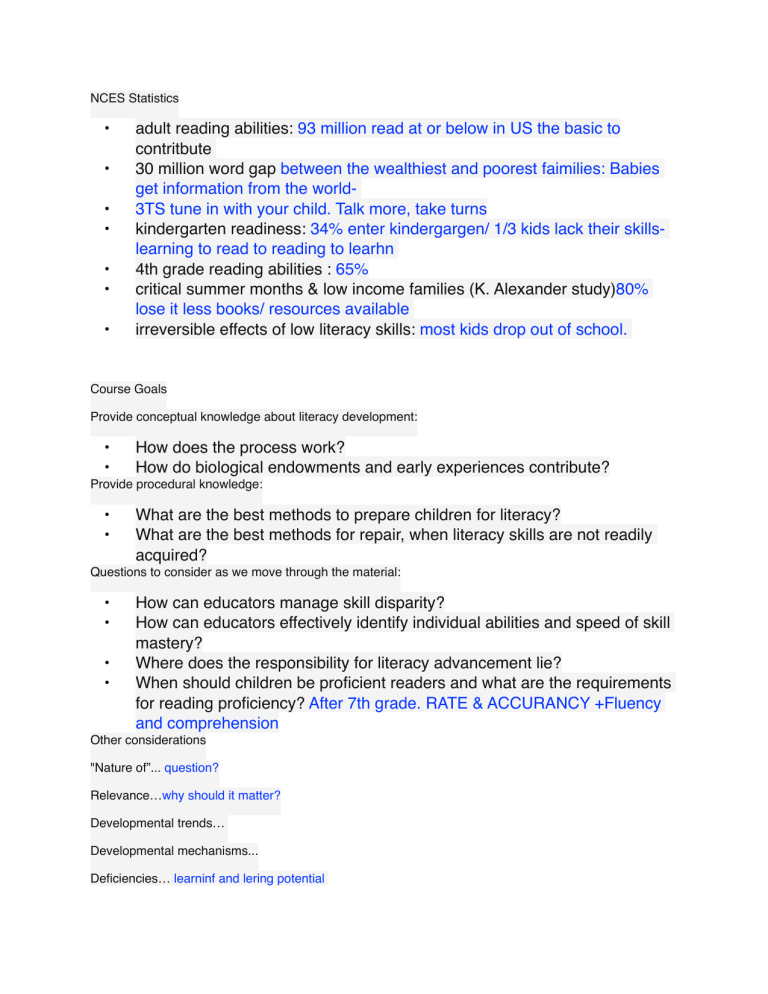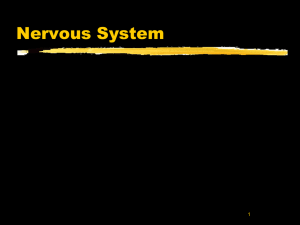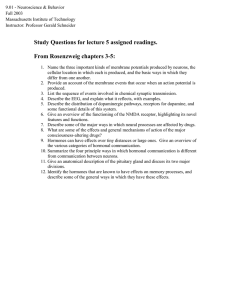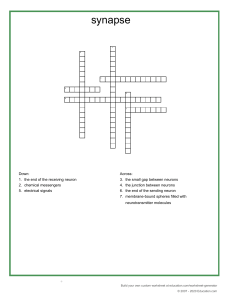
NCES Statistics • • • • • • • adult reading abilities: 93 million read at or below in US the basic to contritbute 30 million word gap between the wealthiest and poorest faimilies: Babies get information from the world3TS tune in with your child. Talk more, take turns kindergarten readiness: 34% enter kindergargen/ 1/3 kids lack their skillslearning to read to reading to learhn 4th grade reading abilities : 65% critical summer months & low income families (K. Alexander study)80% lose it less books/ resources available irreversible effects of low literacy skills: most kids drop out of school. Course Goals Provide conceptual knowledge about literacy development: • • How does the process work? How do biological endowments and early experiences contribute? Provide procedural knowledge: • • What are the best methods to prepare children for literacy? What are the best methods for repair, when literacy skills are not readily acquired? Questions to consider as we move through the material: • • • • How can educators manage skill disparity? How can educators effectively identify individual abilities and speed of skill mastery? Where does the responsibility for literacy advancement lie? When should children be proficient readers and what are the requirements for reading proficiency? After 7th grade. RATE & ACCURANCY +Fluency and comprehension Other considerations "Nature of”... question? Relevance…why should it matter? Developmental trends… Developmental mechanisms... Deficiencies… learninf and lering potential BRAIN DEVELOPMENT Cytoarcitecture: each brain is unique, containg a certain no, of neurons connected to eachother in particular ways. 2 mirror images- DIFFERENT- every single one unique certain no. of neurons/ Gentics and environmental Areal vs Laminar organization: Localization of cognitive functions • • • • double dissociation: damage to one area to brain causes a deficit in one aspect of a skill. Urbach-weithe disease: calcification/degeneration of amygdala- emotion center glial cells: hels provide a hospitable environment so that neurons can do their jobs 1. They provide firmness and structure to the brain 2. They form the myelin sheaths that surround the axons of long neurons which speeds up their firing 3. They provide a scaffold for neurons to latch onto during the process of cell migration. 4. They take up and remove some of the chemical transmitters that are released during synaption transmitters. neurons- responsible for transmitting information pyramidal 80% look like that & stellate laminar layers: layer 1 horizontal fibers 2 3 4stella cells 56 deepest highconcentration Processes of brain development • • • • • • proliferation: are there enough cells? Copiesmigration: are the cells located in the right place? differentiation: process that assures the right number of cells and the right type of cells are located in the right place Growth:neurons grow (axon length) proximity facillitates efficiency & function (synaptic development): form synaptic connections to send and receive messages synaptic connections during fetal development: activation patterns occur spontaneously/ no output from outside world own development.//genetics and infancy/childhood: activation patterns occur when provoked, or stimulated. Piaget: sensoriimotor fxn comes first /// through 5 sensespositive experiences // high SES high gray matter neuronal death: allowance for error// synaptic pruning • pruning: Regressive processess.// death of neuron of weaker Increase from 2-4 decreases after that. Refine signals • dendritic arborization: sprouting of new dentrites • axon myelination: fatty coating speeds up firing- electric impulse Factors affecting brain development • Genetics: Between species differences: Profileration: we have more brain cells in more refined areas Migration & differentiation: provides protective flexibility Within species differences: Despite genetic instructions- such brain is uniquely different Twin studies- same genetic instruction, individual differences. • environmental stimuli: resondsing to the environment, based on uniformity in how info is received. -Role of the brain: afferent neurons brings info to brain via sensory receptotd Cortical neurons receive, process and store information Plasticity: make accomodation for itself • nutrition: Prenatal malnutrition: slows profileration *fewer neurons & fewer glial cells Malnutrition in childhood: slow cell growth/ inhibits myelination Steroids: stress hormones affect neurological development: excessive amounts could promote neuronal deathh in key areas. Inborn structural differences of mals/female brain: sex hormones affec neurological development • teratogens: any foreign substance that can cause harm during the embryonic or fetal stages of development • Association b/w teratgens and their effects are evident / based on DOSE SUSCEPTIBILITY TIME of exposure • -nicotine, alcohol, prescription pain killers, illicit drugs , viruses Constructivist orientation: Nativist: abilities are innate and predetermined Empirical: intelligence is shaped by environmental input Constructivist- nature and nurture are equally importnat -environment is more is more -sooner the better




